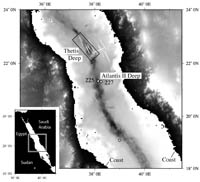 Evaporites deposited during the Miocene in the Red Sea are known to flow into the deeps (volcanic spreading centres) because of the rifting having removed lateral constraints on them. Flowage was revealed spectacularly in multibeam sonar data collected in 2005 and shown here to right. The image shows rounded flow fronts of smooth morphology contrasting with the rugged morphology of volcanic cones, ridges and faults in the floor of the deep. Somewhat like glaciers (hence elsewhere these kinds of features have been called salt glaciers), they show longitudinal troughs and ridges. Also somewhat reminiscent of ice crevasses, small ridges and troughs also run perpendicular to the longitudinal ridges.
Evaporites deposited during the Miocene in the Red Sea are known to flow into the deeps (volcanic spreading centres) because of the rifting having removed lateral constraints on them. Flowage was revealed spectacularly in multibeam sonar data collected in 2005 and shown here to right. The image shows rounded flow fronts of smooth morphology contrasting with the rugged morphology of volcanic cones, ridges and faults in the floor of the deep. Somewhat like glaciers (hence elsewhere these kinds of features have been called salt glaciers), they show longitudinal troughs and ridges. Also somewhat reminiscent of ice crevasses, small ridges and troughs also run perpendicular to the longitudinal ridges.
Mitchell, NC, , M. Ligi, V. Ferrante, E. Bonatti and E. Rutter, Submarine salt flows in the central Red Sea, Bull. Geol. Soc. Am. 122, 701-713. doi:10.1130/B26518.1, 2008.

The work was led by Marco Ligi and Enrico Bonatti of the CNR, Bologna and surveying was carried out on the Italian research vessel Urania. Other work led by Marco has been published in Geology and G3 on the geochemistry and geomechanics of the deep.
The map to left shows our survey location. Grey levels indicate depths from around 2000 m to zero m (black to white at the coastlines).